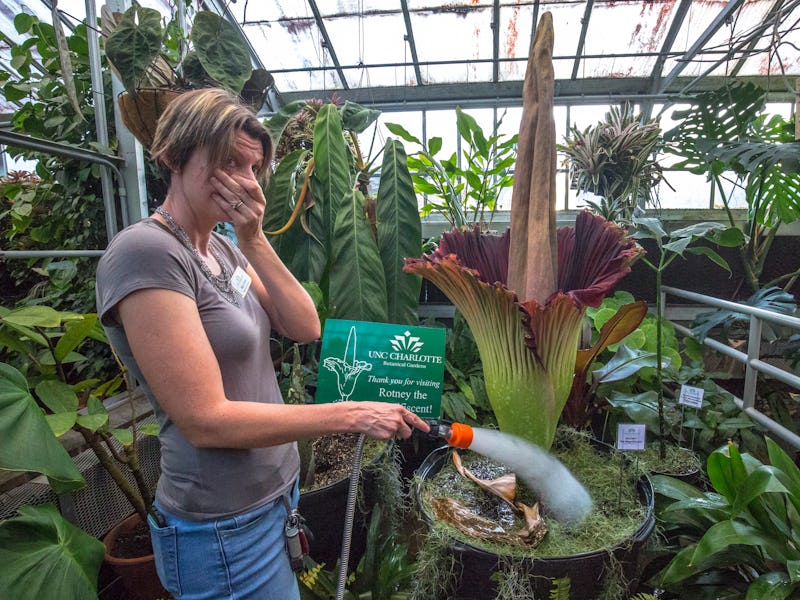New York's Rare Corpse Flower Bloom Will Smell Like Trash and Dead Animals
And people can't wait to get a whiff.

It’s summer, which means the air is filled with familiar smells: charcoal grills, freshly cut grass, maybe weed smoke smoke in the park, and, if you’re anywhere near the New York Botanical Garden, the stench of dead animal stuffed with dirty toilet paper and rolled in rotten cheese. No, it’s not the usual scent of trash on New York City’s streets; this particular aroma wafts off a a corpse flower, the largest flower in the world. The New York Botanical Garden’s rare specimen is due to bloom any day now, unleashing its full stink power for all to smell.
While some flowers attract pollinators by smelling nice, others take a wholly different approach. The corpse flower, also known as a titan arum (Amorphophallus titanum), gets its name from its smell, which resembles rotting flesh, a garbage can, or sweaty socks, depending on whom you ask. When the flower opens up, it doesn’t attract bees or butterflies. It attracts the kind of bugs that would show up to feast on a dead animal or a pile of trash: carrion beetles and flesh flies.
Not only is the blooming event spectacular in its stench. It’s also quite rare: the NYBG’s corpse flower bloomed relatively recently, in 2016, but before that the plant hadn’t bloomed since 1939. This year, a different plant is blooming, and the garden seems to be cashing in on the hype to get people to come in and see it.
But the window to see it if you’re in the area is quite narrow: The big stinky flower only blooms for about 48 hours before the bloom dies. Then it’ll be at least years before it does so again — probably even longer than usual because it’s being cultivated in a greenhouse.
In the corpse flower’s native Sumatra, where conditions for it are ideal, it still only blooms for two days every four to five years. In between blooms, it stores all the energy it accumulates through photosynthesis in its corm, a swollen base stem. For the plant, a bloom is a massive expenditure of energy, which is put into the giant flower. The flower consists of a tall, pale central spadix — which is how the plant got its scientific name, which translates to “giant misshapen penis” — surrounded by the frilly, purple spathe. While blooming, the spadix heats up to about 90 degrees Fahrenheit to dissipate all those stinky chemicals and attract insects. The smell builds throughout the first day, so early visitors can rest assured the stink will only intensify.
Since the flower only blooms occasionally, it has to put on a big show to make sure it attracts pollinators and reproduces successfully. But producing all that heat takes up a lot of energy, and after the short bloom, the flower wilts and the seeds develop. They get eaten by birds, who disperse them in the wild to grow into new corpse flowers.
If you don’t get a chance to go see it, fear not: There’s a livestream where you can watch — but not smell — the whole thing.